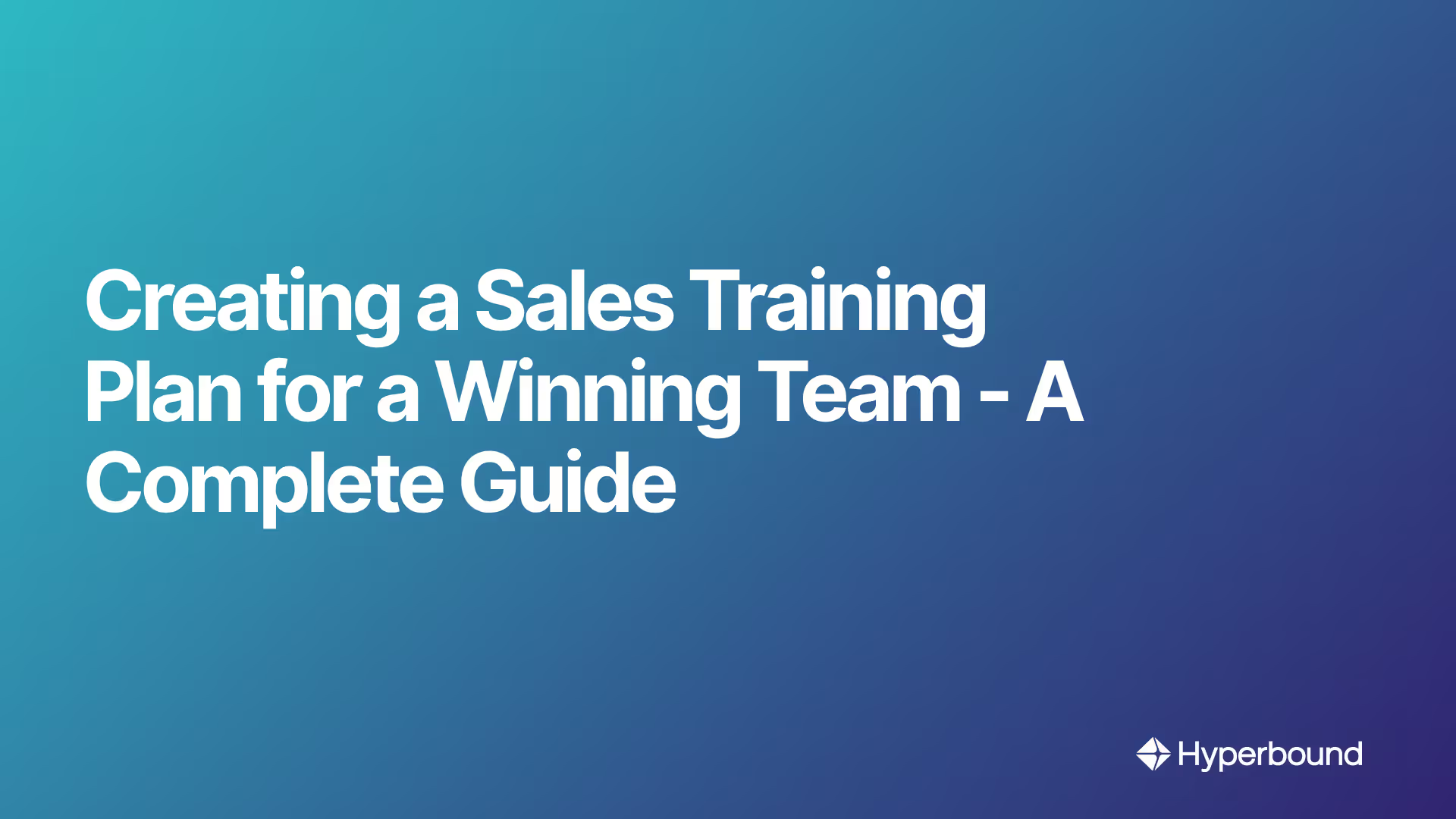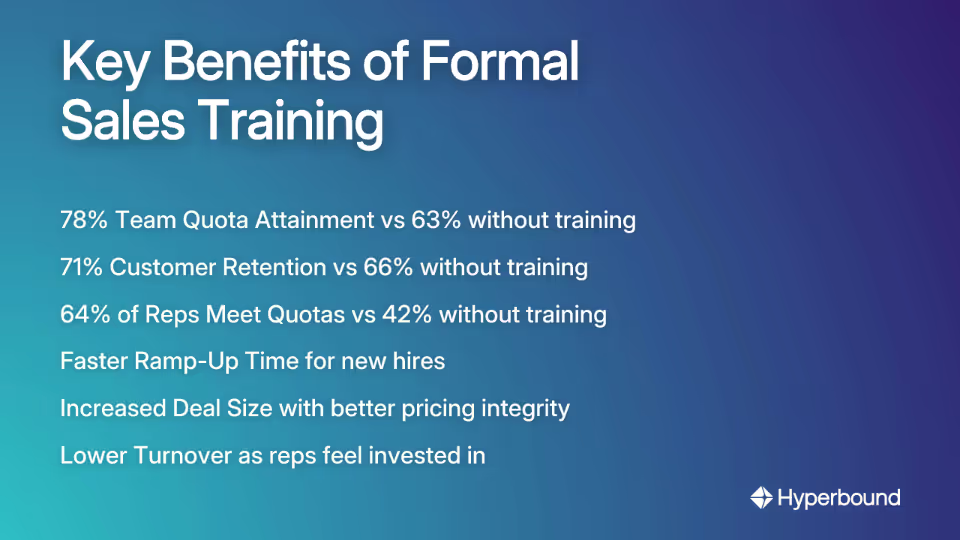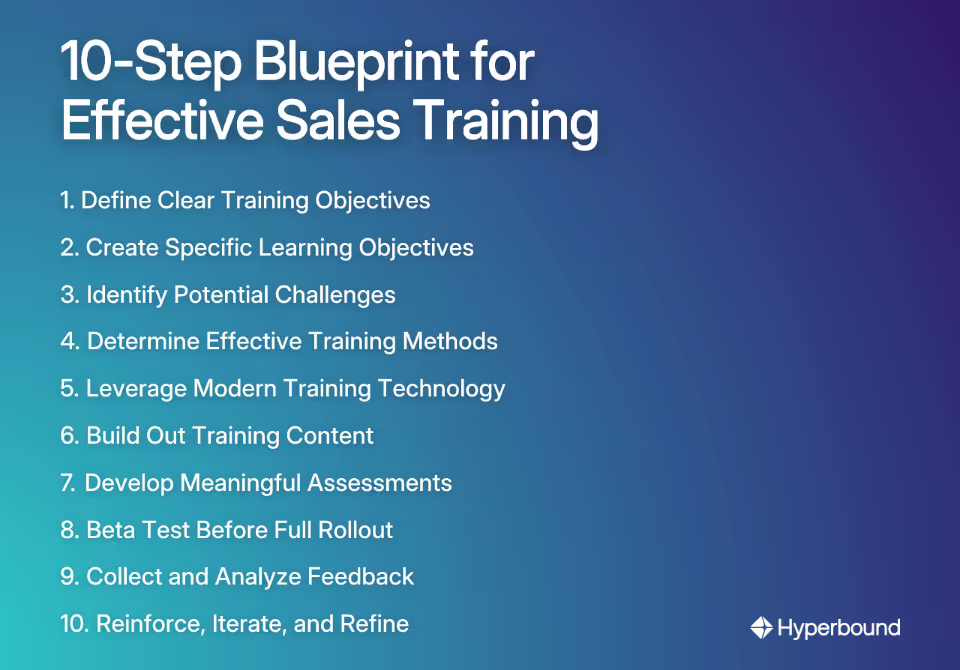
You've just hired an enthusiastic new sales rep who's eager to hit the ground running. After a quick product demo and some basic onboarding, you send them into the field, confident they'll start closing deals right away. Three months later, they're still struggling to meet quota, frustrated by objections they can't handle, and considering whether sales is even the right career for them.
Sound familiar?
"So far I've always been disappointed by the lack of sales training at companies I've worked at. They are usually just a string of recorded product demonstrations made by marketing or someone not actually successfully selling the product(s)," laments one experienced sales professional in a recent Reddit discussion.
The hard truth is that most sales training programs fail to deliver meaningful results. They're often hastily assembled, focused on product features rather than selling skills, and lack the reinforcement needed to create lasting behavior change.
But it doesn't have to be this way.
Effective sales training isn't a one-time event—it's a strategic, ongoing process designed to develop the specific skills your team needs to excel in today's competitive marketplace. When done right, it transforms average performers into sales champions who consistently meet and exceed their targets.
In this comprehensive guide, you'll discover how to create a sales training plan that actually works—one that ramps up new hires faster, equips veterans with advanced techniques, and builds a culture of continuous improvement that drives sustainable revenue growth.
The Foundation: Understanding the "Why" Behind World-Class Sales Training
Before diving into the specifics of building your sales training plan, it's crucial to understand what sets exceptional training apart from the mediocre programs most companies implement.
Sales Training vs. Sales Enablement: Know the Difference
While often used interchangeably, these terms represent distinct but complementary approaches:
- Sales Training focuses on developing the skills and behaviors that salespeople need to be effective. It's about teaching your team how to sell through learning, practice, and reinforcement.
- Sales Enablement provides the tools, content, and resources (like CRM systems or battle cards) that make selling more efficient. It's about equipping your team with what they need to sell.
For optimal results, your sales strategy needs both. Think of it this way: sales enablement without training leads to unused tools, while training without enablement leads to skilled reps hampered by inefficient processes.
The Measurable Impact of Formal Training
If you're wondering whether investing in a comprehensive sales training plan is worth the effort, consider these compelling statistics from an Aberdeen Group study:
- Team Quota Attainment: Companies with formal sales training programs achieve 78% team quota attainment versus just 63% for those without structured training.
- Customer Retention: Organizations that prioritize sales training see 71% customer retention rates compared to 66% for those that don't.
- Individual Rep Quota Attainment: 64% of reps at companies with formal training meet their quotas, while only 42% do so at companies without formal training.
Beyond these impressive numbers, effective training directly impacts other crucial metrics:
- Faster Ramp-Up Time: New hires become productive more quickly, reducing the costly gap between hiring and revenue generation.
- Increased Deal Size: Well-trained reps maintain pricing integrity and avoid unnecessary discounts.
- Lower Turnover: Sales professionals are more likely to stay with companies that invest in their development.

World-Class vs. Typical Training: What's the Difference?
Understanding what separates exceptional training from mediocre programs will help you avoid common pitfalls:
AspectTypical TrainingWorld-Class TrainingApproachShort-term, event-based, disorganizedLong-term, strategic process based on a defined sales competency modelContent FocusProduct features and company informationBalanced mix of product knowledge and core selling skillsDeliveryOne-size-fits-all presentationsBlended learning tailored to different roles and experience levelsReinforcementLittle to none (information quickly forgotten)Consistent practice, coaching, and applicationMeasurementCompletion rates and satisfaction surveysMulti-level evaluation linking training to business outcomes
As one sales rep shares from their most positive experience: "The best sales training I ever had was with a startup for a month. Learned the product inside out, tested, and felt like school. It made the sales cohort closer and better."
This testimonial highlights a crucial aspect of world-class training: it's immersive, thorough, and builds camaraderie among the team—all elements we'll incorporate into our blueprint for success.
The Blueprint: A 10-Step Guide to Designing Your Sales Training Program
Now that you understand why effective sales training matters, let's explore a systematic approach to building a program that delivers measurable results. This 10-step process will guide you from initial planning through implementation and continuous improvement.
Step 1: Define Clear Sales Training Objectives
Start with the end in mind by establishing specific business goals that your training will support. These should be measurable and directly tied to your company's strategic objectives.
Examples of well-defined training objectives include:
- Increase win rates by 15% within six months
- Reduce the sales cycle length by 10%
- Improve customer retention by 20%
- Increase average deal size by 12%
Next, conduct a skill gap analysis to identify the specific areas where your team needs improvement. This could involve:
- Analyzing call recordings
- Reviewing CRM data to identify sticking points in the sales process
- Surveying sales reps about their challenges
- Observing sales calls and meetings
As one sales manager noted in a recent forum discussion, "I'm asking in order to help speed up my learning curve as I have been struggling." Identifying these specific pain points is crucial for creating relevant training.
Step 2: Create Specific Learning Objectives for Salespeople
Translate your business goals into concrete learning objectives that describe what salespeople should be able to do after completing the training. Effective learning objectives are:
- Specific and actionable
- Observable and measurable
- Relevant to job performance
For example:
- "Reps will be able to ask 5 specific discovery questions to uncover customer pain points."
- "Reps will be able to differentiate between genuine objections and negotiation tactics."
- "Reps will be able to craft personalized value propositions for different buyer personas."
These clear objectives provide focus for your training content and make it easier to measure success later.
Step 3: Identify and Plan for Potential Challenges
Anticipate obstacles that might hinder your training implementation:
Common Challenges:
- Scheduling conflicts: Sales teams are busy pursuing quotas, making it difficult to find time for training.
- Geographic dispersion: Remote or distributed teams require special consideration.
- Varying experience levels: New hires and veterans have different needs.
- Attention spans: Sales professionals tend to be action-oriented and may resist classroom-style learning.
- Budget constraints: Limited resources require creative solutions.
By identifying these challenges early, you can develop strategies to address them before they derail your training efforts.
Step 4: Determine the Most Effective Training Methods
Move beyond the "recorded demonstration" model that frustrates so many sales professionals. A world-class sales training plan incorporates a blend of complementary approaches:
Instructor-Led Training (ILT):
- Ideal for introducing new concepts, facilitating discussions, and building team cohesion
- Can be conducted in person or virtually
- Most effective when highly interactive with plenty of practice opportunities
Self-Directed Learning:
- Perfect for product knowledge, pre-work, and reinforcement
- Delivered via Learning Management System (LMS)
- Allows reps to learn at their own pace
Role-Playing & Simulations:
- Essential for practicing skills in a safe environment
- Helps reps "learn to rebound better after losing a sale" by rehearsing difficult conversations
- Can include peer-to-peer role plays, manager-led scenarios, or recorded practice sessions
Peer-to-Peer Learning:
- Encourages mentorship between high performers and newer team members
- Creates a "sales cohort" that fosters camaraderie and shared learning
- Can include ride-alongs, call shadowing, and success story sharing
On-the-Job Training:
- Structured application of skills in real-world selling situations
- Includes coached calls, joint sales meetings, and guided territory planning
- Provides immediate feedback for continuous improvement
The most effective sales training plans combine these methods in a thoughtful sequence that builds skills progressively while accommodating different learning styles.

Step 5: Leverage Modern Sales Training Technology
Today's sales training technology can dramatically enhance the effectiveness and efficiency of your program:
Learning Management System (LMS):
- Centralizes training content and tracks completion
- Enables self-paced learning and microlearning
- Provides analytics on participation and assessment results
AI Sales Coaching and Practice Platforms:
- Platforms like Hyperbound combine conversation intelligence with AI-powered role-plays to create a complete training loop.
- They analyze real customer calls to identify winning behaviors and then allow reps to practice those skills in realistic simulations.
- This provides scalable, on-demand practice and personalized AI coaching to accelerate skill development.
Mobile Learning Apps:
- Deliver bite-sized training reinforcement
- Enable learning during downtime (between meetings, while traveling)
- Support just-in-time learning when reps need specific information
The right technology stack makes training more engaging, accessible, and measurable—critical factors for today's distributed sales teams.
Step 6: Build Out Your Sales Training Content
With your objectives established and delivery methods selected, it's time to develop your training content. Structure your curriculum logically using an instructional design model like ADDIE (Analyze, Design, Develop, Implement, Evaluate).
Essential Components of Effective Sales Training Content:
- Scenario-based learning modules that reflect real-world selling situations
- Case studies showcasing successful implementations and customer outcomes
- Recordings of successful calls demonstrating best practices in action
- Interactive exercises requiring active participation and application
- Job aids and playbooks reps can reference during actual sales activities
- Assessment tools to measure knowledge retention and skill development
Remember that content should be engaging, practical, and directly applicable to your sales process. As one sales professional noted, training fails when it's "just a string of recorded product demonstrations" rather than practical selling guidance.
Step 7: Develop Meaningful Training Assessments
Assessments serve two critical purposes in your sales training plan:
- They validate that learning objectives have been met
- They provide data for measuring training effectiveness
Effective Assessment Methods:
- Knowledge checks: Quizzes, tests, and interactive scenarios to verify understanding
- Skill demonstrations: Role-plays, simulations, and call recordings evaluated against standard criteria
- Certification programs: Formal validation of competency in specific sales methodologies or product areas
- Manager observations: Structured evaluations of skills applied in real selling situations
Design assessments to measure both knowledge (what reps know) and application (what they can do with that knowledge).
Step 8: Deliver the Training (Beta Test First!)
Before rolling out your training program company-wide, test it with a small pilot group. This approach allows you to:
- Identify and fix content gaps or unclear instructions
- Test the technology and logistics
- Gather feedback from participants
- Refine the program based on real-world implementation
Select a diverse pilot group including both new hires and experienced reps to ensure the training works for various experience levels.
Step 9: Collect and Analyze Feedback
Go beyond simple "smile sheets" that only measure satisfaction. Comprehensive feedback should assess:
- Relevance of content to sales roles
- Clarity of instruction and materials
- Effectiveness of delivery methods
- Applicability to real-world selling situations
- Perceived impact on sales performance
Use this feedback to make immediate improvements to your sales training plan before the full rollout.
Step 10: Reinforce, Iterate, and Refine the Process
The biggest failure in sales training is lack of reinforcement. Research shows that without reinforcement, sales reps forget up to 87% of training content within 30 days.
Effective Reinforcement Strategies:
- Manager coaching: Equip sales managers to observe, provide feedback, and coach to the trained skills
- Spaced repetition: Schedule regular refreshers on key concepts
- Peer accountability: Create structures for reps to practice together and give feedback
- Performance incentives: Recognize and reward application of new skills
- Continuous improvement: Regularly update training based on performance data and changing market conditions
As one sales leader emphasizes, "Yes, I can do the best possible training, provide the person with recorded phone calls, success stories, motivation—but it will still take them time to find their voice while speaking with customers." Reinforcement bridges this gap between training and mastery.

Core Curriculum: Essential Skills and Methodologies for Modern Sales Teams
A comprehensive sales training plan must cover certain fundamental skills, regardless of your industry or sales model. These core competencies form the foundation of sales success:
Key Sales Skills to Develop
Sales Prospecting:Go beyond basic cold calling techniques. Your sales training plan should teach reps sophisticated approaches to:
- Research accounts using social media and other digital tools
- Identify key decision-makers and influencers
- Craft personalized outreach that resonates with prospects
- Develop multi-touch, multi-channel prospecting sequences
Programs like Fanatical Prospector offer specialized training in this critical skill that determines pipeline health.
Curiosity & Discovery:The foundation of consultative selling is asking insightful questions and truly listening to understand customer needs. Train your team to:
- Prepare strategic discovery questions for different buyer personas
- Listen actively and take meaningful notes
- Identify both explicit and implicit customer needs
- Connect discovered needs to your solution's capabilities
As methodologies like Selling Through Curiosity emphasize, the rep who asks the best questions—not the one who talks the most—usually wins the deal.
Storytelling:Help your team move beyond feature-dumping to engage customers with compelling narratives:
- Craft customer success stories with clear before/after scenarios
- Personalize stories to specific industries or use cases
- Use analogies to explain complex concepts
- Create emotional connections through relatable examples
Communication & Presentation Skills:Whether in virtual or face-to-face environments, how your team communicates matters tremendously:
- Virtual meeting management and engagement techniques
- Executive presence when presenting to C-Suite buyers
- Visual aid creation and utilization
- Handling difficult questions with confidence
Closing Skills & Objection Handling:Even the best discovery becomes meaningless without the ability to advance deals to closure:
- Recognize buying signals and create momentum
- Address common objections with confidence
- Negotiate effectively while maintaining margins
- Create "upfront contracts" (a key concept from Sandler Training) to establish clear next steps
The ability to "rebound better after losing a sale" is also crucial. Your training should build resilience and help reps learn from unsuccessful deals rather than becoming discouraged by them.
Role-Based Training
One size doesn't fit all when it comes to sales training. Your plan should include specialized content for different roles on your team:
SDRs/BDRs (Sales/Business Development Representatives):Focus on top-of-funnel activities:
- Prospecting techniques and tools
- Qualification frameworks (like BANT or CHAMP)
- Objection handling during initial outreach
- Effective hand-offs to Account Executives
Account Executives:Emphasize middle and bottom-of-funnel skills:
- In-depth discovery and needs analysis
- Solution presentation and demonstration
- Negotiation and closing techniques
- Competitive positioning and differentiation
Account Managers:Concentrate on customer retention and growth:
- Relationship management strategies
- Identifying expansion opportunities
- Customer success planning
- Handling service issues effectively
By tailoring training to specific roles, you ensure that each team member receives relevant content that directly impacts their performance metrics.
Choosing and Integrating a Sales Methodology
A formal sales methodology provides a common language and process framework for your entire team. It's the key to predictable revenue and consistent execution.
Popular methodologies to consider include:
MEDDIC/MEDDPICC:A qualification framework that helps reps assess opportunity quality by identifying key elements:
- Metrics (quantifiable value)
- Economic Buyer
- Decision Criteria
- Decision Process
- Identify Pain
- Champion
- Competition
- Paperwork (contracting process)
Value Selling:Focuses on articulating and quantifying the specific value your solution delivers to each customer's unique situation.
The Challenger Sale:Emphasizes teaching prospects new insights about their business and constructively challenging their thinking.
Sandler Training:Centered on building trust through authentic conversations and creating "upfront contracts" that establish clear expectations at each stage.
Your chosen methodology must be reinforced throughout your sales training plan and integrated into your CRM to ensure consistent application. As one sales leader notes, "If it's not in the CRM, it doesn't exist."
Measuring What Matters: Using the Kirkpatrick Model to Evaluate Training ROI
How do you know if your sales training plan is actually working? The Kirkpatrick Model, used for over 60 years, provides a comprehensive framework for evaluating training effectiveness across four levels:
Level 1: Reaction
Goal: Measure how participants feel about the training experience.
Key Questions:
- Did participants find the training engaging and relevant?
- Was the content applicable to their specific role?
- Did they feel the time investment was worthwhile?
- How likely are they to recommend the training to colleagues?
Measurement Techniques:
- Post-training surveys
- Focus groups
- Participation rates and completion statistics
- Informal feedback
While important, this level only captures immediate impressions and doesn't indicate whether learning occurred or if behavior will change.
Level 2: Learning
Goal: Assess the increase in knowledge, skills, and attitudes resulting from the training.
Key Questions:
- Did participants actually learn the intended content?
- Can they demonstrate the skills taught?
- Have their attitudes about selling changed?
- Do they understand the sales methodology being implemented?
Measurement Techniques:
- Pre- and post-training knowledge assessments
- Skills demonstrations through role-plays
- Certifications based on skill mastery
- Self-assessment of confidence levels
This level confirms that learning occurred but doesn't guarantee application on the job.
Level 3: Behavior
Goal: Determine if participants apply their new knowledge and skills in their actual work.
Key Questions:
- Are reps using the discovery questions taught in training?
- Are they logging MEDDPICC fields in the CRM?
- Have they adopted the objection handling techniques?
- Are they implementing the negotiation strategies?
Measurement Techniques:
- Manager observation during call reviews
- CRM data analysis showing methodology adoption
- Metrics from AI coaching platforms like Hyperbound, which track the application of trained skills on live calls
- Peer feedback and coaching notes
This level is critical because it bridges the gap between learning and results. As one sales leader noted, "No matter the good training, it still takes time to find their voice while speaking with customers." Level 3 evaluation helps track this crucial transition.
Level 4: Results
Goal: Measure the tangible business outcomes linked to the training program.
Key Questions:
- Did win rates increase after training?
- Has the sales cycle length decreased?
- Are average deal sizes larger?
- Has customer retention improved?
Measurement Techniques:
- Sales performance metrics comparison (before vs. after)
- Pipeline conversion rate analysis
- Quota attainment statistics
- Customer satisfaction and retention data
This final level connects your sales training plan directly to business results, providing justification for the investment and insights for future improvements.
By systematically evaluating all four levels, you can:
- Identify which aspects of training are most effective
- Pinpoint areas needing reinforcement or redesign
- Demonstrate clear ROI to leadership
- Make data-driven decisions about future training investments
From Training Event to Continuous Improvement: Building a Culture of Sales Excellence
Creating an effective sales training plan isn't a one-time project—it's an ongoing commitment to developing your team's capabilities in alignment with evolving market demands and business objectives.
The most successful sales organizations view training not as an event but as a continuous improvement system that:
- Establishes a baseline of essential skills and knowledge
- Reinforces learning through consistent practice and application
- Measures progress against clear performance indicators
- Adapts content based on changing conditions and feedback
- Celebrates growth to motivate ongoing development
As you implement your sales training plan, remember that patience and persistence are essential. "Yes, I can filter out the best person from the interviews. Yes, I can do the best possible training, provide the person with recorded phone calls, success stories, motivation—but it will still take them time to find their voice while speaking with customers," notes one sales leader.
This realistic perspective acknowledges that even the best sales training plan requires time to yield results. The key is creating a supportive environment where:
- Managers reinforce training through regular coaching
- Peers share insights and best practices
- Systems capture and disseminate winning techniques
- Leadership demonstrates commitment to continuous learning
By approaching sales training as a strategic, ongoing process rather than a checkbox activity, you build a foundation for sustainable competitive advantage through sales excellence.
Taking the First Step
The journey to a world-class sales training program begins with a single step. Whether you're starting from scratch or improving an existing program, consider these initial actions:
- Conduct a skill gap analysis to identify your team's most pressing development needs
- Interview top performers to understand what sets them apart
- Review your sales process to ensure training aligns with how you actually sell
- Evaluate available technologies that could enhance your training delivery
- Create a pilot program focused on one critical skill area
Remember that the most effective sales training plan is one that's actually implemented, measured, and continuously improved. As the saying goes in sales, "Perfect is the enemy of done." Start where you are, use what you have, and build momentum through consistent execution.
By following the blueprint outlined in this guide, you'll create a sales training plan that transforms your team's capabilities, accelerates revenue growth, and establishes a culture of sales excellence that becomes your sustainable competitive advantage.
Your sales team is waiting. What will you teach them today?
Frequently Asked Questions (FAQ)
What is the difference between sales training and sales enablement?
Sales training focuses on developing a salesperson's skills (the how to sell), while sales enablement provides them with the tools and resources to sell more efficiently (the what they need to sell). For best results, a company needs a strategy that integrates both. Training without enablement leads to skilled reps who are inefficient, while enablement without training leads to unused tools.
Why do most sales training programs fail?
Most sales training programs fail because they are treated as one-time events rather than an ongoing process. Common pitfalls include focusing too much on product features instead of core selling skills, lacking practical application through role-play, and failing to provide consistent reinforcement and coaching, which causes reps to forget up to 87% of what they learned.
What are the most essential skills for a modern sales training program?
A modern sales training program should focus on core competencies beyond product knowledge. Essential skills include sales prospecting, discovery and active listening, storytelling, communication and presentation skills, and closing and objection handling. These skills form the foundation for consultative selling and are crucial for adapting to various customer situations.
How can you measure the effectiveness and ROI of sales training?
You can measure sales training ROI using a multi-level approach like the Kirkpatrick Model. This involves evaluating four key areas: 1) Reaction (participant feedback), 2) Learning (knowledge and skill acquisition), 3) Behavior (on-the-job application of new skills), and 4) Results (tangible business outcomes like increased win rates, larger deal sizes, and shorter sales cycles).
What is the best way to train a remote sales team?
The best way to train a remote sales team is to use a blended learning approach that leverages modern technology. This includes virtual instructor-led training for interactive sessions, self-directed learning modules on an LMS for flexibility, and AI-powered platforms for scalable role-play and coaching. This combination ensures training is accessible, engaging, and accommodates different schedules and learning paces.
How do you ensure sales training is effective for both new hires and experienced veterans?
To make training effective for all experience levels, you must tailor the content and delivery. New hires need foundational training on product, processes, and core skills. Experienced veterans benefit more from advanced workshops, peer-to-peer learning with other top performers, and coaching on specific, nuanced skills. A one-size-fits-all approach is rarely effective.
What is the single most important factor for making sales training stick?
The single most important factor is consistent reinforcement. Without it, sales reps forget most of what they learn within a month. Effective reinforcement includes ongoing manager coaching, scheduled refreshers, peer practice sessions, and integrating the trained concepts and methodologies directly into daily tools like the CRM. Training must be a continuous process, not a one-time event.

Book a demo with Hyperbound
.png)













